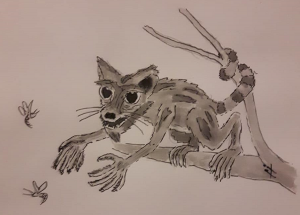Wysp Snatch
From World of Entorais Wiki
Jump to navigationJump to searchAbout
- Wysp snatches are a smallish arboreal furred creatures, known for a regular diet of insects and a strong preference for wysps, of which they seem immune to the stings. They have quick agile reflexes and exceptionally dexterous paws.
- Common Names
- Wysp Snatches
Description
- Classification
- Mammal
- Size
- 5-8 kg (11-18 pounds), body 0.4 m (16 inches), tail 0.4 metres (16 inches).
- Appearance
- Lean bodied, with long legs and arms ending in long digit paws, the fingers of which are edged in long bristles which allow them to form net-like structures to aid in capture of flying insects, and other prey. Wysp snatches have a prehensile tail, used for anchoring themselves to branches when moving about or hunting. They have long pointed jaws and nose with very large pointed ears and wide eyes.
- Sexual dimorphism
- Little difference between the sexes, besides the external sex organs, females have eight teats notable when nursing young.
- Variance
- Wysp snatches come in a variety of colours and patterns which provide a measure of camouflage or mate selection adapted to their particular forest biomes. There are also some species which have significantly different behaviours or adaptations.
Ecology
- Habitat
- Arboreal canopy dwellers of Tropical to Sub-Arctic forests.
- Diet
- Omnivorous eating a variety of insects, and the occasional small bird, lizard, or other animal. They are known to eat fruit, nuts and leaves as well.
Behaviour
- Social grouping
- Wysp snatches are often encounter in closely related groups of up to a dozen members. They may spread out when hunting, and gather together in larger numbers when resting during the night.
- Temperament
- Skittish, Wysp snatches will flee from larger animals, and watch from a distance to determine threats. Individuals within a group can be observed standing watch while others hunt and feed.
- Intelligence
- Clever animal
- Reproduction
- Wysp snatches mate in late Autumn, and build large wintering nests from branches, twigs and gathered leaves. Females will birth between six and eight young during the early spring, who are ready to leave the nest riding about on the backs of adults after a month. Young become fully autonomous after their third month.
Notable Sub-Species
Common Wysp Snatch
- The common wysp snatch has a pelt in soft browns, cream, black or grey. They have short beards on their chins, and some have tufts on the cheeks. Their tails are usually a single shade, tipped in a different colour.
Gliding Wysp Snatch
- Gliding wysp snatches resemble common wysp snatches, with slightly shorter than average limbs and tails. They also possess patagia extending along each flank connecting their fore limbs and hind limbs. They are capable of leaping and gliding over fair distances, and often use this to capture prey on the wing that would be otherwise out of reach.
Ring Tailed Wysp Snatch
- This variety of wysp snatch has a mottled fiery red and light brown pelt, with six or seven distinctive red bands along the tail. They also have a short beard on their chin.
Domestication
- General
- Wysp snatches can be raised for food, or even working animals to control vermin in orchards and farms. However their omnivorous nature means they sometimes damage the crops they are employed to protect, so they require vigilant monitoring to discourage such behaviour.
- Resources
- Meat, Pelts.
